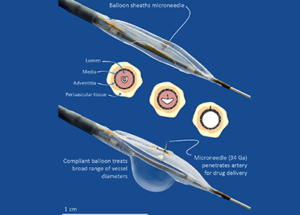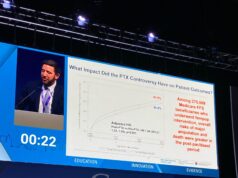
Peripheral artery disease patients who were treated with an anti-inflammatory steroid injected directly into the tissue surrounding their leg artery showed a significant reduction in inflammatory biomarkers.
Results from the DANCE trial (Dexamethasone infusion to the adventitia to enhance clinical efficacy after femoropopliteal revascularisation) were presented as a late-breaking clinical trial at the Society for Cardiovascular Angiography and Interventions (SCAI) 2017 scientific sessions on 11 May in New Orleans, USA.
Treatment approaches that treat blockages from the inside of the artery can trigger a cycle of inflammation that may contribute to restenosis. Over the course of six to 12 months, a meaningful percentage of patients experience a repeat blockage due to restenosis, a press release from SCAI states.
Researchers in the DANCE trial measured the inflammatory biomarkers in a patient subgroup (n=52 who underwent angioplasty and n=42, who underwent atherectomy) before and after using the Bullfrog microinfusion device to locally deliver dexamethasone (1.6mg/cm of treated artery) after their angioplasty or atherectomy, and a control group (n=12 who underwent angioplasty and n=16 who underwent atherectomy) that did not receive the steroid following the same techniques. Both groups had blood drawn prior to intervention, at 24-hours, and at four weeks post-procedure. Patients treated with the microinfusion device and dexamethasone experienced a significant reduction of two key inflammatory biomarkers that have been linked to restenosis in balloon angioplasty interventions: high-sensitivity C-reactive protein (hsCRP) and monocyte chemoattractive protein-1 (MCP-1).
“This is a novel approach to treating the diseased artery by administering a steroid to the tissue that surrounds it,” said one of the study’s leading investigators Ehrin J Armstrong, VA Eastern Colorado Healthcare System and associate professor of medicine, University of Colorado School of Medicine. “By injecting anti-inflammatory drug directly into the artery wall and the adjacent tissue, as opposed to inside the artery where much of the drug could be washed away by blood flow, the drug is precisely targeted to the site of the inflammatory signals. Thus, the cycle of inflammation that can lead to repeat blockages is controlled, and the healing process is potentially improved.”
In the control group, the average 24-hour increase in hsCRP was 280% with angioplasty or 138% with atherectomy as compared to 55% with angioplasty or 14% in the atherectomy group in treated patients. Additionally, a 24-hour mean rise in MCP-1 of 19% or 14% was seen in the non-treated group, while treated patients experienced a reduction of 39% or 52%.
Armstrong noted, “The way we address a blockage in the leg artery now is to initially restore blood flow and any limitation to the blood flow dynamics using a balloon or stent to mechanically open the artery back up. The idea behind the addition of a steroid to the procedure is to change the underlying biology associated with these techniques so that the intervention is more durable over time. The DANCE study has provided insight that the measurement of the levels of the inflammatory biomarkers for individual patients may be a beneficial strategy in predicting outcomes and lead to improvement by personalising our therapy for each peripheral arterial disease patient.”













